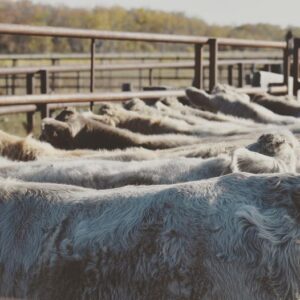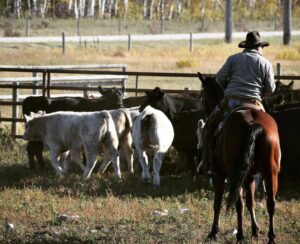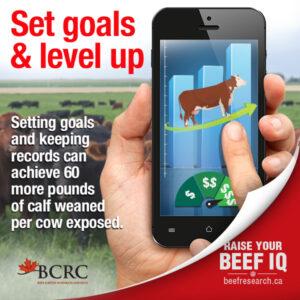Every Farm Has Different Goalposts – Setting Goals and Defining Success
What does a “successful” Canadian beef farm look like? How do you define success on your farm?
Canfax and the Beef Cattle Research Council recently released the results from their Canadian Cow-calf Cost of Production Network. The project collected data from 115 beef producers across Canada and summarized production benchmarks such as cow size, weaning weight and calf mortality. The network also looked at profit and expense benchmarks like feed costs, cow depreciation, enterprise revenue and more. A detailed summary of these results can be found here.
Interested in the Canadian Cow-Calf Cost of Production Network?Producers receive:
Sign up at: https://www.canfax.ca/COPNetwork.aspx |
While profit and production numbers are often touted as measures of success, participants in the Cost of Production Network pointed out that fiscal targets are not their only focus. Success looks different for every farm because individual goals and values vary. Some producers may put a spotlight on strategies to increase revenue and reduce costs while other farmers view success as working well with family members or having less overall stress. All definitions are important and worth striving for.
Andre and Katie Steppler were named Manitoba Region’s Outstanding Young Farmers (OYF) in 2020. They manage the cattle division of Steppler Farms, where they run purebred and commercial Charolais herds as well as the recent addition of a registered Black Angus herd.
While winning the OYF award may be the very definition of success for most farmers, Steppler, who works alongside his three brothers, their families and his parents near Miami, Manitoba, is quick to point out that there is no single goal or target that makes their multigenerational farm work. “It’s about shared visions and goals and it’s a revolving thing,” he says. “You can’t stand still.”
Profits and Production

“I’m very financial oriented – and our farm is too,” says Andre. Their farm is comprised of cattle, cash cropping and honeybee enterprises, and each entity submits an annual budget including cash flows and balance sheets. “We track it all the way through the year,” he says, and that determines how their respective divisions will invest profits back into their business. At the end of each year, their accountant breaks down their return-on-investment by enterprise. “How much are we achieving back?” he asks, and adds that in his case, herd improvement may be tied to financial goals. For example, if he sets a goal to elevate their breeding program by buying a certain bull, it becomes a financial goal to be able to generate revenue to afford that investment.
| Are you curious about which areas of your operation are excelling? Or which areas need some work? The BCRC has a complete set of record-keeping and benchmarking resources for production, finances, forage, and more. Level 1 – Introductory Some farms may not fit exactly into one level for all topics, but producers can select resources to suit their on-farm needs. |
In the purebred cattle world, some people use measures such as show ring success or having the high-selling bull of the year, but Andre says they use a different yardstick. “We’re not goal-oriented where we need to win a show or have the highest sales average. Our goal is to be relevant – that’s the benchmark,” Steppler says.
When it comes to a cattle record-keeping system, Steppler is looking to make changes. “We track everything through our purebred associations, but that’s one thing I watch from afar is different cow-calf production metrics we could use,” Andre says. Certification programs are good motivation to shift their records away from pen and paper toward something computerized. “Everything is automated and simple and easy, that will be a movement in the near future,” he says.
It’s Time to Get Personal
While their farm has undergone a formal succession plan, Andre says looking back, it’s important to pay closer attention to more than finances and production. “It’s great when a succession plan happens but it doesn’t stop there. Just because you’ve succeeded doesn’t mean it’s over,” he says. Personal goals vary and need to be considered in order for a successful outcome. “My [personal] goals are different than everyone else’s,” he explains. “You need a transition plan that puts security into everyone’s visions and allows everyone to do what they want to do,” Andre adds.
Participants in the Cost of Production Network outlined many types of personal success, including achieving a balanced lifestyle, reducing stress, having a good quality of life, maintaining passion and ownership in their farming operation, and having success in their relationships and within their family. These targets are harder to quantify than dollars and cents, and can shift over time, but are no less important.
Public Trust
Participants in the Cost of Production Network also identified societal goals that were important to their definition of success. Some of these included having the public perceive them as positive stewards of the land or having the ability to operate environmentally sustainable businesses. Many producers indicated they wanted to be known for producing a quality product, building a legacy, using regenerative or holistic practices, having a positive impact on animal welfare, and being able to do “more with less.”
For Andre and Katie Steppler, improving public trust is valuable and the OYF program elevated their ability to hit mainstream media. “One of the best parts was an ability to be a young farmer advocating to spread the message that there is progression, innovation, and young enthusiastic farmers out there,” Andre says. “The media sometimes talks about how farmers are old, how we’re losing our connection to rural areas, but there are youth and innovation and business people as well,” he explains. “We’re just like you who live in the city, we go to hockey games, we’re parents, we are involved in our communities and we also raise food.”
Your Network is Your Net Worth
The Stepplers say surrounding themselves with good people has been key for them. “My inner circle is a pretty big circle,” Andre says. He talks often with his nutritionist, his veterinarian and a core group of commercial and purebred breeders. “If they need to phone me or I need to phone them, neither of us is afraid to tell it like it is and look out for each other and build on each others’ ideas,” he explains.

Andre says they also leveraged their network to help market cattle in uncertain times caused by the COVID pandemic. When restrictions were potentially threatening upcoming sales, he leaned on good mentors to discuss strategies to help them forge ahead with online and social media marketing. “Last year’s female and this year’s bull sale ended up being a record for us,” he says.
With the drought, Steppler again found working as a team to be worthwhile. “We’re not used to being dry,” says Andre, who is a director with the Manitoba Beef Producers. “The drought impacted my clients as well as district members who I was representing,” he explains, and adds he used his social media presence to create awareness. “It helped us to access media to heighten communications around drought and hopefully turn the needle a bit,” he says.
The dry conditions forced the family to look at some hard numbers, Andre admits. With reduced feed supplies, they put their emotions aside and switched gears for the cow herd. “When we made those [budgets] in December, come June and July we knew we wouldn’t meet our feed target, so we had to start pivoting,” he says. They decided to preg-check and wean early and sell open cows, with the plan of keeping the herd out of the yard as long as possible.Success can be a moving target, particularly in challenging times. Yet when beef producers set clear goals and work toward them, the journey can be both personally fulfilling and financially prosperous. Everything doesn’t always go according to plan, but reviewing personal benchmarks and taking an honest look at what worked and perhaps what did not, can shine a light on progress.
Producers interested in signing up for the Canadian Cow-calf Cost of Production Network January-March 2022 Focus Groups can learn more here.
Learn More:
- What is a Successful Farm? (Cost of Production Network Video)
- Why a Cost of Production Network? (BCRC Blog Post)
- Networks Make the Dream Work (BCRC Blog Post)
- A New Approach to Cost of Production Benchmarking (BCRC Blog Post)
Click here to subscribe to the BCRC Blog and receive email notifications when new content is posted.
The sharing or reprinting of BCRC Blog articles is welcome and encouraged. Please provide acknowledgement to the Beef Cattle Research Council, list the website address, www.BeefResearch.ca, and let us know you chose to share the article by emailing us at info@beefresearch.ca.
We welcome your questions, comments and suggestions. Contact us directly or generate public discussion by posting your thoughts below.
